
- 4 号 p. 349-
- 3 号 p. 241-
- 2 号 p. 135-
- 1 号 p. 1-
- |<
- <
- 1
- >
- >|
-
Richiro Ushimaru2024 年 72 巻 3 号 p. 241-247
発行日: 2024/03/01
公開日: 2024/03/01
ジャーナル フリー HTMLNatural products from plants and microorganisms provide a valuable reservoir of pharmaceutical compounds. C–C bond formation and cleavage are crucial events during natural product biosynthesis, playing pivotal roles in generating diverse and intricate chemical structures that are essential for biological functions. This review summarizes our recent findings regarding biosynthetic enzymes that catalyze unconventional C–C bond formation and cleavage reactions during natural product biosynthesis.
 抄録全体を表示PDF形式でダウンロード (2464K) HTML形式で全画面表示
抄録全体を表示PDF形式でダウンロード (2464K) HTML形式で全画面表示
-
Akira Kotani2024 年 72 巻 3 号 p. 248
発行日: 2024/03/01
公開日: 2024/03/01
ジャーナル フリー HTMLPDF形式でダウンロード (181K) HTML形式で全画面表示
-
Masaki Toda, Kyoko Sugiyama, Fumiya Sato, Yusuke Sasano, Tsutomu Fujim ...2024 年 72 巻 3 号 p. 249-252
発行日: 2024/03/01
公開日: 2024/03/01
ジャーナル フリー HTMLElectrochemical enzyme sensors are suitable for simple monitoring methods, for example, as glucose sensors for diabetic patients; however, they have several disadvantages arising from the properties of the enzyme. Therefore, non-enzymatic electrochemical sensors using functional molecules are being developed. In this paper, we report the electrochemical characterization of a new hydroxylamine compound, 7-azabicyclo[2.2.1]heptan-7-ol (ABHOL), and its application to glucose sensing. Although the cyclic voltammogram for the first cycle was unstable, it was reproducible after the second cycle, enabling electrochemical analysis of ethanol and glucose. In the first cycle, ABHOL caused complex reactions, including electrochemical oxidation and comproportionation with the generated oxoammonium ions. The electrochemical probe performance of ABHOL was more efficient than the typical nitroxyl radical compound, 2,2,6,6-tetramethylpiperidine-1-oxyl (TEMPO), and had similar efficiency to 9-azabicyclo[3.3.1]nonane N-oxyl (ABNO), which is activated by the bicyclic structure. The results demonstrated the advantages of ABHOL, which can be synthesized from inexpensive materials via simple methods.
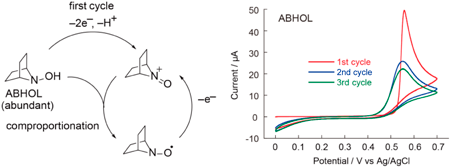 抄録全体を表示PDF形式でダウンロード (1058K) HTML形式で全画面表示
抄録全体を表示PDF形式でダウンロード (1058K) HTML形式で全画面表示
-
Hikaru Ikeda, Akira Tokonami, Shigeki Nishii, Masashi Fujita, Yojiro Y ...2024 年 72 巻 3 号 p. 253-257
発行日: 2024/03/01
公開日: 2024/03/01
ジャーナル フリー HTMLThis study focused on the electrochemical properties of tetrazolium salts to develop a simple method for evaluating viable bacterial counts, which are indicators of drug susceptibility. Considering that the oxidized form of tetrazolium, which has excellent cell membrane permeability, changes to the insoluble reduced form formazan inside the cell, the number of viable cells was estimated based on the reduction current of the tetrazolium remaining in the bacterial suspension. Dissolved oxygen is an important component of bacterial activity. However, it interferes with the electrochemical response of tetrazolium. We estimated the number of viable bacteria in the suspension based on potential-selective current responses that were not affected by dissolved oxygen. Based on solubility, cell membrane permeability, and characteristic electrochemical properties of the tetrazolium salt 3-(4,5-dimethylthiazol-2-yl)-2,5-diphenyltetrazolium, we developed a method for rapidly measuring viable bacteria within one-fifth of the time required by conventional colorimetric methods for drug susceptibility testing.
 抄録全体を表示PDF形式でダウンロード (1134K) HTML形式で全画面表示
抄録全体を表示PDF形式でダウンロード (1134K) HTML形式で全画面表示 -
Michiru Ito, Kazuharu Sugawara2024 年 72 巻 3 号 p. 258-265
発行日: 2024/03/01
公開日: 2024/03/01
ジャーナル フリー HTML
電子付録Glycated albumin (GA) is one of the proteins that replaces several sugar moieties and can be used as an indicator of diabetes mellitus. We developed a sensing system that uses GA in the early detection of diabetes mellitus. In this study, H6Y4C acetylated (Ac-) at the N-terminals of the peptide was combined with wheat germ agglutinin (WGA) to recognize glucose moieties. The Ac-H6Y4C-WGA was constructed as a GA-sensing probe. The tyrosine residues of Y4C exhibited an oxidation peak, and His-tag moieties were introduced to separate Ac-H6Y4C-WGA in the synthesis of the probe. The Ac-H6Y4C-WGA probe binds with the 1–2 molecules of Ac-H6Y4C per WGA using matrix assisted laser desorption/ionization-time of flight (MALDI-TOF)-MS. Next, the functions of Ac-H6Y4C-WGA were evaluated using voltammetry. The number of electron-transfers was calculated based on the relationship between the peak potential and logarithm of scan rate and was 3.03. In the electrochemical measurements with mannose and bovine serum albumin, the peak currents were similar to that of GA alone. By contrast, a decrease in the peak current was suppressed when glucose was added to the solution containing the probe. As a result, Ac-H6Y4C-WGA was selectively bound to the glucose moieties of GA. The calibration curve via differential pulse voltammetry was proportional to the concentrations of GA and ranged from 1.0 × 10−12 to 2.0 × 10−11 M with a detection limit of 3.3 × 10−13 M.
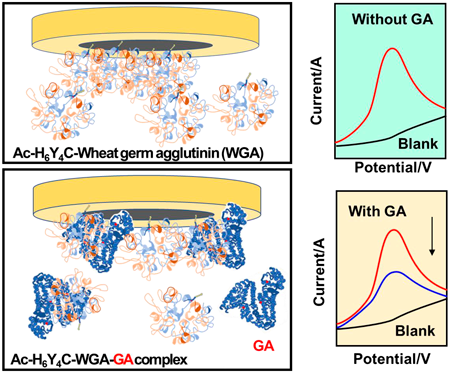 抄録全体を表示PDF形式でダウンロード (1800K) HTML形式で全画面表示
抄録全体を表示PDF形式でダウンロード (1800K) HTML形式で全画面表示 -
Akira Kotani, Miyu Sakazume, Koichi Machida, Kazuhiro Yamamoto, Hideki ...2024 年 72 巻 3 号 p. 266-270
発行日: 2024/03/01
公開日: 2024/03/01
ジャーナル フリー HTML
電子付録In this study, an electrochemical analysis, coupled with the concept of back neutralization titration and the voltammetric determination of surplus acid, is proposed for determining the total alkalinity of water samples. When linear sweep voltammetry of 3,5-di-tert-butyl-1,2-benzoquinone (DBBQ) with H2SO4 in a water and ethanol (44 : 56, v/v) mixture was carried out using a bare glassy carbon working electrode, a cathodic prepeak of DBBQ caused by H2SO4 was observed on the voltammogram at a more positive potential than when compared with the original cathodic peak of DBBQ. When similar voltammetry was carried out in the presence of Na2CO3 and H2SO4, the cathodic prepeak height of DBBQ was decreased with an increase in the Na2CO3 concentration. The decrease of the cathodic prepeak height of DBBQ was found to be linearly related to the Na2CO3 concentration ranging from 0.025 to 2.5 mM (r2 = 0.998). The total equivalent concentrations of inorganic bases in samples of mineral water and tap water were determined, and then the results were converted to the total alkalinities of the water samples (mg/L CaCO3). The total alkalinities of the water samples determined by the present electrochemical analysis were essentially the same compared with those by the neutralization titration method. From these results, we were able to demonstrate that the present electrochemical analysis with accuracy and precision could be applied to determine the total alkalinity, which is one of the indicators to examine water quality. The present electrochemical analysis would contribute to achieving the sustainable development goals (SDGs) of #6 and #14.
 抄録全体を表示PDF形式でダウンロード (649K) HTML形式で全画面表示
抄録全体を表示PDF形式でダウンロード (649K) HTML形式で全画面表示 -
 Fumiki Takahashi, Yuki Shimosaka, Shuki Mori, Mayu Kaneko, Yuta Haraya ...2024 年 72 巻 3 号 p. 271-279
Fumiki Takahashi, Yuki Shimosaka, Shuki Mori, Mayu Kaneko, Yuta Haraya ...2024 年 72 巻 3 号 p. 271-279
発行日: 2024/03/01
公開日: 2024/03/01
ジャーナル フリー HTML
電子付録Codeine is a common analgesic drug that is a pro-drug of morphine. It also has a high risk of abuse as a recreational drug because of its extensive distribution as an OTC drug. Therefore, sensitive and selective screening methods for codeine are crucial in forensic analytical chemistry. To date, a commercial analytical kit has not been developed for dedicated codeine determination, and there is a need for an analytical method to quantify codeine in the field. In the present work, potential modulation was combined with electrochemiluminescence (ECL) for sensitive determination of codeine. The potential modulated technique involved applying a signal to electrodes by superimposing an AC potential on the DC potential. When tris(2,2′-bipyridine)ruthenium(II) ([Ru(bpy)3]2+) was used as an ECL emitter, ECL activity was confirmed for codeine. A detailed investigation of the electrochemical reaction mechanism suggested a characteristic ECL reaction mechanism involving electrochemical oxidation of the opioid framework. Besides the usual ECL reaction derived from the amine framework, selective detection of codeine was possible under the measurement conditions, with clear luminescence observed in an acidic solution. The sensitivity of codeine detection by potential modulated-ECL was one order of magnitude higher than that obtained with the conventional potential sweep method. The proposed method was applied to codeine determination in actual prescription medications and OTC drug samples. Codeine was selectively determined from other compounds in medications and showed good linearity with a low detection limit (150 ng mL−1).
 抄録全体を表示Editor's pickPDF形式でダウンロード (1892K) HTML形式で全画面表示
抄録全体を表示Editor's pickPDF形式でダウンロード (1892K) HTML形式で全画面表示
-
Xiangming Wang, Menghui Zhao, Chengguo Ju, Hui Gao, Wei Wang2024 年 72 巻 3 号 p. 280-285
発行日: 2024/03/06
公開日: 2024/03/06
[早期公開] 公開日: 2024/02/07ジャーナル フリー HTMLThis study investigated the hepatoprotective effects of Juncus effusus (J. effusus) and Carbonized J. effusus against liver injury caused by D-galactosamine (D-GalN) in mice. J. effusus and Carbonized J. effusus were administered by gavage once daily starting seven days before the D-GalN treatment. The results of the study indicated that J. effusus and Carbonized J. effusus suppressed the D-GalN-induced generation of serum alanine transaminase (ALT), aspartate aminotransferase (AST), hepatic malondialdehyde (MDA) and tumor necrosis factor-alpha (TNF-α) was observed. The values of superoxide dismutase (SOD) exhibited an increase. In addition, J. effusus and Carbonized J. effusus promoted the protein expression of nuclear factor erythroid 2-related factor 2 (Nrf2), NADPH quinone oxidoreductase-1 (NQO-1), heme oxygenase-1 (HO-1) as well as the mRNA expression of Nrf2, HO-1, NQO-1 and Glutamate cysteine ligase catalytic subunit (GCLC). The compressed Carbonized J. effusus demonstrated the optimum impact. These results suggest that J. effusus and Carbonized J. effusus protect against D-GalN-induced acute liver injury through the activation of the Nrf2 pathway.
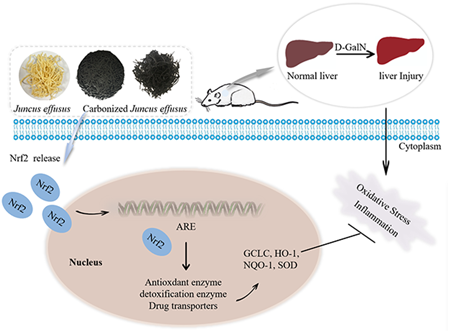 抄録全体を表示PDF形式でダウンロード (4065K) HTML形式で全画面表示
抄録全体を表示PDF形式でダウンロード (4065K) HTML形式で全画面表示 -
Effect of Concomitant Drugs on Sodium Zirconium Cyclosilicate Hydrate in Artificial Intestinal JuiceYuri Mizuno, Fumihiko Ogata, Yugo Uematsu, Naohito Kawasaki2024 年 72 巻 3 号 p. 286-293
発行日: 2024/03/06
公開日: 2024/03/06
ジャーナル フリー HTMLTo explore drug interactions involving sodium zirconium cyclosilicate hydrate (SZC) and concomitant drugs like calcium antagonists (amlodipine and nifedipine) and β-blockers (carvedilol and bisoprolol), we investigate how these concomitant drugs influenced the administration of SZC in an artificial intestinal juice. Initially, we assessed the potassium ion adsorption capacity, ranking it as follows: calcium polystyrene sulfonate (CPS, 54.9 mg/g) < sodium polystyrene sulfonate (SPS, 62.1 mg/g) < SZC (90.8 mg/g). However, the adsorption equilibrium was achieved in the order of CPS ≒ SPS (within 1 min) < SZC (within 1 h). Subsequently, we determined the residual percentages of amlodipine, nifedipine, carvedilol, and bisoprolol, finding them to be 79.0–91.9% for SZC, 0.38–38.4% for SPS, and 0.57–29.0% for CPS. These results suggest the efficacy of SZC in managing hyperkalemia alongside concomitant drugs in an artificial intestinal juice, with particular emphasis on amlodipine (calcium antagonist) and carvedilol (β-blocker). Additionally, we identified the presence of carbon, nitrogen, and oxygen components from both drugs on the SZC surface following interaction. We also evaluated how amlodipine, nifedipine, carvedilol, and bisoprolol affected the administration of SZC in the presence of potassium ions. Our results indicate that potassium ions and concomitant drugs did not interfere with each other in the artificial intestinal juice. These results offer valuable insights into the administration of SZC in conjunction with concomitant drugs. Lastly, the presented data shows qualitative results in this study.
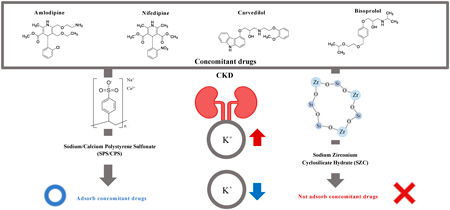 抄録全体を表示PDF形式でダウンロード (4450K) HTML形式で全画面表示
抄録全体を表示PDF形式でダウンロード (4450K) HTML形式で全画面表示
-
Akihiro Yokoyama, Ayaka Chino, Kenta Rakumitsu2024 年 72 巻 3 号 p. 294-297
発行日: 2024/03/08
公開日: 2024/03/08
ジャーナル オープンアクセス HTML
電子付録Aiming to synthesize a cyclic hexaamide, 4-bromo-3-(isobutylamino)benzoic acid was subjected to self-condensation reactions in the presence of either dichlorotriphenylphosphorane in 1,1,2,2-tetrachloroethane or tetrachlorosilane in pyridine. However, instead of the targeted cyclic hexaamide, the cyclic triamide and the cyclic tetraamide were obtained. The cyclic hexaamide was successfully synthesized via the self-condensation of the dimer, which was synthesized in five steps from 4-bromo-3-(isobutylamino)benzoic acid. A thorough screening of the self-condensation conditions was performed to improve the yield of the target macrocycle. In addition, the linear hexamer was synthesized by stepwise deprotection and condensation, and its cyclization afforded the cyclic hexaamide in good yield.
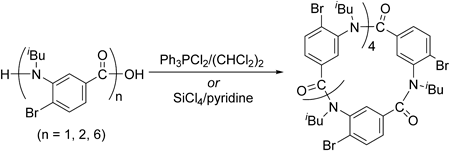 抄録全体を表示PDF形式でダウンロード (561K) HTML形式で全画面表示
抄録全体を表示PDF形式でダウンロード (561K) HTML形式で全画面表示
-
Masaki Higashino, Kiyohiko Sugano2024 年 72 巻 3 号 p. 298-302
発行日: 2024/03/13
公開日: 2024/03/13
ジャーナル フリー HTMLThe current study aimed to explore the impact of buffer species on the dissolution behavior of orally disintegrating tablets (ODT) containing a basic polymer and its influence on bioequivalence (BE) prediction. Fexofenadine hydrochloride ODT formulations were used as the model formulations, Allegra® as the reference formulation, and generic formulations A and B as the test formulations. Allegra®, generic A, and generic B are ODT formulations that contain aminoalkyl methacrylate copolymers E (Eudragit® E, EUD-E), a basic polymer commonly used to mask the bitter taste of drugs. Both generic A and generic B have been known to be bioequivalent to Allegra®. The dissolution tests were conducted using a compendial paddle, with either bicarbonate (10 mM, pH 6.8) or phosphate buffer (25 mM, pH 6.8) as the dissolution media. A floating lid was employed to cover the surface of the bicarbonate buffer to prevent volatilization. Results indicated that in phosphate buffer, the dissolution profiles of Allegra and generic B significantly varied from that of generic A, whereas in the bicarbonate buffer, the dissolution profiles of Allegra, generic A, and generic B were comparable. These findings suggest that the use of bicarbonate buffer may offer a more precise prediction of human bioequivalence compared to phosphate buffer.
 抄録全体を表示PDF形式でダウンロード (1484K) HTML形式で全画面表示
抄録全体を表示PDF形式でダウンロード (1484K) HTML形式で全画面表示 -
Keisuke Yoshida, Wataru Hirano, Ryuuki Ota, Shinji Kitagaki2024 年 72 巻 3 号 p. 303-308
発行日: 2024/03/12
公開日: 2024/03/12
ジャーナル オープンアクセス HTML
電子付録Amine-free phosphorylation of various alcohols was developed with 4-methylpyridine N-oxide in the presence of 4 Å molecular sieves at room temperature. This mild method gave various phosphorylated products in high yield and could be applied to acid- or base-sensitive substrates. Furthermore, this method was also effective for the chemoselective phosphorylation of diols or polyols.
 抄録全体を表示PDF形式でダウンロード (739K) HTML形式で全画面表示
抄録全体を表示PDF形式でダウンロード (739K) HTML形式で全画面表示
-
Chiyuki Awahara, Daiki Oku, Kazuya Kobayashi, Yasunao Hattori2024 年 72 巻 3 号 p. 309-310
発行日: 2024/03/14
公開日: 2024/03/14
ジャーナル フリー HTML
電子付録The inhibition mode of a retro-inverso (RI) inhibitor containing a hydroxyethylamine dipeptide isostere against the human T-cell leukemia virus type-1 (HTLV-1) protease was examined. Enzymatic evaluation of the RI-modified inhibitor containing a D-allo-Ile residue revealed that HTLV-1 was competitively inhibited. IC50 values of the RI-modified inhibitor and pepstatin A, a standard inhibitor of aspartic proteases, were nearly equivalent.
 抄録全体を表示PDF形式でダウンロード (373K) HTML形式で全画面表示
抄録全体を表示PDF形式でダウンロード (373K) HTML形式で全画面表示 -
 Takuya Kobayakawa, Hikaru Takano, Takahiro Ishii, Peter Bolah, Kohei T ...2024 年 72 巻 3 号 p. 311-312
Takuya Kobayakawa, Hikaru Takano, Takahiro Ishii, Peter Bolah, Kohei T ...2024 年 72 巻 3 号 p. 311-312
発行日: 2024/03/16
公開日: 2024/03/16
ジャーナル オープンアクセス HTMLAn improvement of the two-photon excitation was achieved using 8-azacoumarin-type caged compounds, which showed large values of the two-photon uncaging action cross-section (δu >0.1 Goeppert–Mayer (GM)). In particular, the 7-hydroxy-6-iodo-8-azacoumarin (8-aza-Ihc)-caged compound showed an excellent uncaging action cross-section value (δu = 1.28 GM). Therefore, 8-azacoumarin-type photolabile protecting groups (PPGs) can be used as two-photon excitation sources.
 抄録全体を表示Editor's pickPDF形式でダウンロード (369K) HTML形式で全画面表示
抄録全体を表示Editor's pickPDF形式でダウンロード (369K) HTML形式で全画面表示
-
 Haruki Kanda, Ayaka Okabe, Shingo Harada, Tetsuhiro Nemoto2024 年 72 巻 3 号 p. 313-318
Haruki Kanda, Ayaka Okabe, Shingo Harada, Tetsuhiro Nemoto2024 年 72 巻 3 号 p. 313-318
発行日: 2024/03/16
公開日: 2024/03/16
ジャーナル オープンアクセス HTML
電子付録Generating reliable data on functional group compatibility and chemoselectivity is essential for evaluating the practicality of chemical reactions and predicting retrosynthetic routes. In this context, we performed systematic studies using a functional group evaluation kit including 26 kinds of additives to assess the functional group tolerance of carbene-mediated reactions. Our findings revealed that some intermolecular heteroatom–hydrogen insertion reactions proceed faster than intramolecular cyclopropanation reactions. Lewis basic functionalities inhibited rhodium-catalyzed C–H functionalization of indoles. While performing these studies, we observed an unexpected C–H functionalization of a 1-naphthol variant used as an additive.
 抄録全体を表示Editor's pickPDF形式でダウンロード (1906K) HTML形式で全画面表示
抄録全体を表示Editor's pickPDF形式でダウンロード (1906K) HTML形式で全画面表示
-
Kathrine Anne Flores, Akie Okada, Florencio Arce Jr., Gerard Lee See, ...2024 年 72 巻 3 号 p. 319-323
発行日: 2024/03/20
公開日: 2024/03/20
ジャーナル フリー HTMLAuraptene (Aur) is a naturally occurring monoterpene coumarin ether that exhibits numerous therapeutic properties. Its high lipophilicity and low skin penetration, however, limit its potential application for local and transdermal delivery. Biocompatible non-ionic sugar esters (SEs) possess beneficial properties for the development of transdermal formulations in delivering pharmaceutically challenging molecules such as graphene and Aur. In the present study, we conducted a series of experiments to demonstrate the effect of several previously unstudied SEs on the skin permeation and distribution of Aur by preparing gel- and dispersion-type formulations. Skin permeation and deposition experiments were conducted using a Franz diffusion cell with rat skin as the membrane. The dispersion-type formulations prepared using SEs had higher entrapment efficiency, as well as better skin permeation and retention profiles. The dispersion-type formulation containing sucrose palmitate (sSP) exhibited the highest skin permeation over 8 h. Notably, the enhancement effects on Aur concentration in full-thickness skin after the application of the dispersion-type formulation was higher than those of the control formulation. These results indicated that the prepared formulation has potential for use in the transdermal delivery of Aur in pharmaceutical and cosmetic products.
 抄録全体を表示PDF形式でダウンロード (1129K) HTML形式で全画面表示
抄録全体を表示PDF形式でダウンロード (1129K) HTML形式で全画面表示
-
 Riho Ogawa, Kouji Hara, Ayaka Kobayashi, Nobuyoshi Yoshimura, Yutaka T ...2024 年 72 巻 3 号 p. 324-329
Riho Ogawa, Kouji Hara, Ayaka Kobayashi, Nobuyoshi Yoshimura, Yutaka T ...2024 年 72 巻 3 号 p. 324-329
発行日: 2024/03/21
公開日: 2024/03/21
ジャーナル オープンアクセス HTML
電子付録Polymeric nanofibers generated via electrospinning offer a promising platform for drug delivery systems. This study examines the application of electrospun polyvinyl alcohol (PVA) nanofibers for controlled lysozyme (LZM) delivery. By using various PVA grades, such as the degree of polymerization/hydrolysis, this study investigates their influence on nanofiber morphology and drug-release characteristics. LZM-loaded PVA monolithic nanofibers having 50% drug content exhibit efficient entrapment, wherein rapid dissolution is achieved within 30 min. The initial burst of LZM from the nanofiber was reduced as the LZM content was lowered. The initial dissolution is greatly influenced by the choice of PVA grade used; fully hydrolyzed PVA nanofibers demonstrate controlled release due to the reduced water solubility of PVA. Furthermore, coaxial electrospinning, which creates core–shell nanofibers with polycaprolactone as a controlled release layer, enables sustained LZM release over an extended period. This study confirms a correlation between PVA characteristics and controlled drug release and provides valuable insights into tailoring nanofiber properties for pharmaceutical applications.
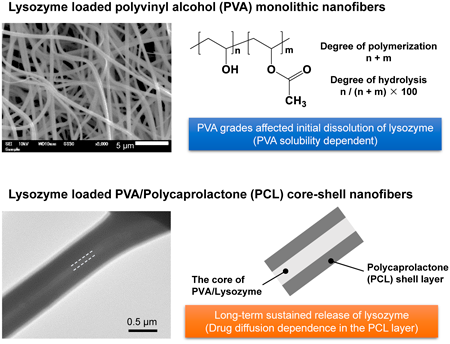 抄録全体を表示Editor's pickPDF形式でダウンロード (2575K) HTML形式で全画面表示
抄録全体を表示Editor's pickPDF形式でダウンロード (2575K) HTML形式で全画面表示 -
Reon Takeuchi, Junko Fujimoto, Yoshinori Taguchi, Ryuji Ide, Ryuji Kya ...2024 年 72 巻 3 号 p. 330-335
発行日: 2024/03/25
公開日: 2024/03/25
ジャーナル フリー HTML
電子付録A 12-keto-type oleanolic acid derivative (4) has been identified as a potent anti-human immunodeficiency virus type-1 (HIV-1) compound that demonstrates synergistic effects with several types of HIV-1 neutralizing antibodies. In the present study, we used a common key synthetic intermediate to carry out the late-stage derivatization of an anti-HIV compound based on the chemical structure of a 12-keto-type oleanolic acid derivative. To execute this strategy, we designed a diketo-type oleanolic acid derivative (5) for chemoselective transformation, targeting the carboxy group and the hydroxyl group on the statine unit, as well as the 3-carbonyl group on the oleanolic acid unit, as orthogonal synthetic handles. We carried out four types of chemoselective transformations, leading to identification of the indole-type derivative (16) as a novel potent anti-HIV compound. In addition, further optimization of the β-hydroxyl group on the statine unit provided the R-4-isobutyl γ-amino acid-type derivative (6), which exhibited potent anti-HIV activity comparable to that of 4 but with reduced cytotoxicity.
 抄録全体を表示PDF形式でダウンロード (2648K) HTML形式で全画面表示
抄録全体を表示PDF形式でダウンロード (2648K) HTML形式で全画面表示
-
 Synthesis of 2-Substituted Indoles via Migration Reaction of 3-Substituted Indoles with Triflic AcidKosuke Nakashima, Yuka Kudo, Yasuyuki Matsushima, Shin-ichi Hirashima, ...2024 年 72 巻 3 号 p. 336-339
Synthesis of 2-Substituted Indoles via Migration Reaction of 3-Substituted Indoles with Triflic AcidKosuke Nakashima, Yuka Kudo, Yasuyuki Matsushima, Shin-ichi Hirashima, ...2024 年 72 巻 3 号 p. 336-339
発行日: 2024/03/25
公開日: 2024/03/25
ジャーナル フリー HTMLThis study showcases the 1,2-migration reactions of alkyl and aryl groups on the indole molecule. Trifluoromethanesulfonic acid effectively facilitates the migration of the substituent from C3- to C2-position of the indole structure. The resulting C2-substituted indoles offer a valuable pathway for the synthesis of natural products and medicinal compounds.
 抄録全体を表示Editor's pickPDF形式でダウンロード (506K) HTML形式で全画面表示
抄録全体を表示Editor's pickPDF形式でダウンロード (506K) HTML形式で全画面表示
-
Hiroaki Ichimaru, Masashi Kurimoto, Shigetoshi Kikuchi2024 年 72 巻 3 号 p. 340-344
発行日: 2024/03/28
公開日: 2024/03/28
ジャーナル フリー HTML
電子付録In clinical diagnosis, magnetic polystyrene nanoparticles (MPS NPs) are commonly applied to, e.g., the chemiluminescent immunoassay (CLEIA). However, the conventional preparation method of MPS NPs requires a long duration of heating to form polymer particles, which is inefficient. In this study, we prepared MPS NPs by emulsion solvent-evaporation without heating. We evaluated the effect of the solvent in the water and organic phases on the magnetic particle content. MPS NPs prepared by 4% (v/v) MeOH aqueous solution and adding stearic acid (SA) (4MeSA–MPS NPs) exhibited the highest magnetic particle content. Furthermore, CLEIA analysis indicates that the C-reactive protein detection limit is 80 pg/mL. Thus, 4MeSA–MPS NPs are promising for clinical diagnoses.
 抄録全体を表示PDF形式でダウンロード (5633K) HTML形式で全画面表示
抄録全体を表示PDF形式でダウンロード (5633K) HTML形式で全画面表示 -
Makoto Okada, Takashi Nose2024 年 72 巻 3 号 p. 345-348
発行日: 2024/03/30
公開日: 2024/03/30
ジャーナル オープンアクセス HTMLEperisone Hydrochloride was launched in Japan in 1983 and has been used to improve muscle tone and treat spastic paralysis (Originator: Eisai Co., Ltd.). However, its biochemical mechanism of action is unknown. SB Drug Discovery was used to evaluate purinergic P2X (P2X) receptor antagonism using fluorescence. In this study, we discovered that its target protein is the P2X7 receptor. Also, P2X receptor subtype selectivity was high. This finding demonstrates the (Eperisone-P2X7-pain linkage), the validity of P2X7 as a drug target, and the possibility of drug repositioning of Eperisone Hydrochloride.
 抄録全体を表示PDF形式でダウンロード (472K) HTML形式で全画面表示
抄録全体を表示PDF形式でダウンロード (472K) HTML形式で全画面表示
- |<
- <
- 1
- >
- >|